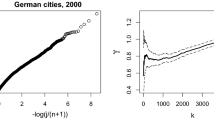Abstract
This note presents a simple and locally optimal test statistic for the Pareto law. The test is based on the Lagrange multiplier principle and can be computed easily once the maximum likelihood estimator of the scale parameter of the Pareto density has been obtained. A Monte Carlo exercise shows the good small sample properties of the test under the null of the Pareto law and also its power against some sensible and interesting alternatives. In addition, the proposed test is compared to a goodness of fit test which is powerful against more or less all alternatives. Eventually, a simple application to urban economics is performed.
Similar content being viewed by others
References
Aban IB, Meerschaert MM (2004) Generalized least-squares estimators for the thickness of heavy tails. J Stat Plann Inference 119: 341–352
Aitchison J, Silvey SD (1958) Maximum-likelihood estimation of parameters subject to restraints. Ann Math Stat 29: 813–828
Beirlant J, Goegebeur Y, Segers J, Teugels J (2004) Statistics of extremes: theory and applications. Wiley, Chichester
Bera AK, Ghosh A (2002) Neyman’s smooth test and its applications in econometrics. In: Ullah A, Wan A, Chaturvedi, A (eds) Handbook of applied econometrics. Marcel Dekker, New York, pp 177–230 http://papers.ssrn.com/sol3/papers.cfm?abstract_id=272888. Accessed Sept 2012
Brown JH, West GB (2000) (eds) Scaling in biology. Oxford University Press, Oxford
Burr IW (1942) Cumulative frequency functions. Ann Math Stat 13: 215–232
Champernowne D (1953) A model of income distribution. Econ J 63: 318–351
Clauset A, Shalizi CR, Newman MEJ (2009) Power-law distributions in empirical data. SIAM Rev 51:661–703. http://arxiv.org/abs/0706.1062v1. Accessed Sept 2012
Eeckhout J (2004) Gibrat′s law for (all) cities. Am Econ Rev 94: 1429–1451
Embrechts P, Kluppelberg P, Mikosch C (1997) Modelling extremal events for insurance and finance. Springer, New York
Fan CC, Casetti E (1994) The spatial and temporal dynamics of US regional income inequality, 1950–1989. Ann Reg Sci 28: 177–196
Gabaix X (1999) Zipf’s law for cities: an explanation. Q J Econ 114: 739–767
Gabaix X (2009) Power laws in economics and finance. Annu Rev Econ 1:255–294. doi:10.1146/annurev.economics.050708.142940. Accessed Sept 2012
Gabaix X, Ibragimov (2011) Rank-1/2: a simple way to improve the OLS estimation of tail exponents. J Bus Econ Stat 29:24–39. doi:10.1198/jbes.2009.06157. Accessed Sept 2012
Gabaix X, Ioannides YM (2004) The evolution of city size distributions. In: Henderson JV, Thisse JF (eds) Handbook of regional and urban economics, vol 4, Chap. 53. North-Holland Publishing Company, Amsterdam
Gibrat R (1931) Les inégalités économiques. Applications: aux inégalités des richesses, à la concentration des entreprises, aux populations des villes, aux statistiques des familles, etc., d’une loi nouvelle, la loi de l’effet proportionnel. Libraire du Recueil Sirey, Paris
Gini C (1912) Variabilità e mutabilità, contributo allo studio delle distribuzioni e relazioni statistiche. Studi Economico-Giuridici dell’ Universiti di Cagliari No. 3, part 2, Cagliari
Goerlich FJ, Mas M (2010) La distribución empírica del tamaño de las ciudades en España, 1900–2001. ¿‘Quién verifica la ley de Zipf?. Rev Econ Apl XVIII, 54, (Winter):133–159
Hill BM (1975) A simple general approach to inference about the tail of a distribution. Ann Stat 3(5): 1163–1174
Johnson NL, Kotz S (1970) Distributions in statistics: continuous univariate distributions, vol 1. Houghton Mifflin Company, Boston
Kallenberg WCM, Ledwina T (1997) Data-driven smooth tests when the hypothesis is composite. J Am Stat Assoc 92:1094–1104. doi:10.1080/01621459.1997.10474065. Accessed Sept 2012
Levy M, Solomon S (1996) Power laws are logarithmic Boltzmann laws. Int J Mod Phys C 7:595–601. http://arxiv.org/abs/adap-org/9607001v1. Accessed Sept 2012
Ministerio de Fomento (2000) Atlas estadístico de las áreas urbanas de España, 1st edn. Centro de Publicaciones, Ministerio de Fomento, Madrid
Muniruzzaman ANM (1957) On measures of location and dispersion and tests of hypothesis in a Pareto population. Bull Calcutta Stat Assoc 7: 115–123
Nishiyama Y, Osada S (2004) Statistical theory of rank size rule regression under Pareto distribution. Discussion Paper No. 009 (January), 21COE, Interfaces for advanced economic analysis, Kyoto University. http://www.kier.kyoto-u.ac.jp/coe21/dp/01-10/DP009-nishiyama%26oasada.pdf. Accessed Sept 2012
Nishiyama Y, Osada S, Sato Y (2008) OLS estimation and the t test revisited in rank-size rule regression. J Reg Sci 48:691–716. [Erratum in J Reg Sci (2009) 49, 1 (February):241]
Pareto V (1896) Cours d’Economie politique. Droz, Geneva
Rosen KT, Resnick M (1980) The size distribution of cities: an examination of the Pareto law and primacy. J Urban Econ 8: 165–186
Silvey SD (1959) The lagrangian multiplier test. Ann Math Stat 30: 389–407
Simon HA (1955) On a class of skew distribution functions. Biometrika 42: 425–440
Sornette D (2004) Critical phenomena in natural sciences. Springer, Berlin
Sornette D, Cont R (1997) Convergent multiplicative processes repelled from zero: power laws and truncated power laws. J Phys I Fr 7: 431–444
Sutton J (1997) Gibrat’s legacy. J Econ Lit 35: 40–59
Urzúa CM (2000) A simple and efficient test for Zipf’s law. Econ Lett 66: 257–260
Zipf G (1949) Human behavior and the principle of least effort. Addison-Wesley, Cambridge
Author information
Authors and Affiliations
Corresponding author
Electronic Supplementary Material
Rights and permissions
About this article
Cite this article
Goerlich, F.J. A simple and efficient test for the Pareto law. Empir Econ 45, 1367–1381 (2013). https://doi.org/10.1007/s00181-012-0654-5
Received:
Accepted:
Published:
Issue Date:
DOI: https://doi.org/10.1007/s00181-012-0654-5



